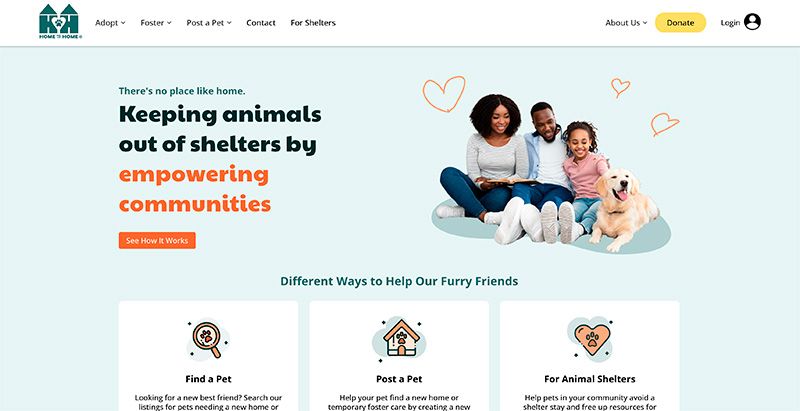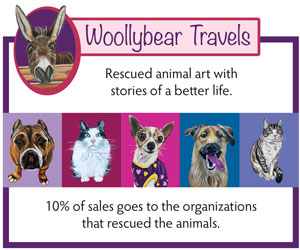The power of supported self-rehoming
By empowering owners to adopt out pets they can’t keep, shelters are reducing intakes and sparing pets the stress of a shelter stay

It’s a familiar conversation for anyone working in a shelter: A community member has made the difficult decision to surrender their pet.
According to recent data from Shelter Animals Count, almost 30% of shelter intakes come from people who needed to relinquish their pets, often because of housing restrictions, behavioral issues or crises in the owner’s life, such as a medical diagnosis. For many organizations, finding space for these animals can be a challenge. Even when space is available, the transition to a shelter environment can cause pets a lot of stress.
Over the past decade, shelters have increasingly responded with a simple yet effective solution: Skip the shelter altogether and help people find new homes for pets on their own.
Pets being rehomed outside the shelter system is nothing new. “The community has been doing this forever, whether shelters want them to do it or not,” says Lindsay Hamrick, director of shelter outreach and engagement at Humane World for Animals.
What’s new is that shelters are embracing the practice and providing pet owners with resources to guide them through the process.
Evolving perspectives
For a long time, the sheltering field promoted the message that if people couldn’t keep their pets, the best solution was to take them to their local shelter, says Mandy Evans, executive director of Better Together Animal Alliance in Idaho. Underlying the message was the belief that the public was irresponsible and needed to be treated with strict precautions.
Today, there’s a growing understanding that nearly all adopters have good intentions. Numerous studies have also brought a deeper understanding of how animals experience shelter life and the problems that can result when organizations exceed their capacity for care.
As the field’s historic skepticism of self-rehoming gives way to new perspectives, the number of shelters implementing supported self-rehoming programs has “picked up a lot of speed” over the past five years, says April Huntsman, senior director of animal welfare at Adopt a Pet.
Along with helping to divert intakes, such programs provide an important service for community members who prefer to rehome a pet on their own. Some may fear being judged by shelter staff for giving up a pet or want to choose who adopts their animal. They may also worry that their pet won’t cope well inside a shelter—a concern that researchers have found to be justified.
Even the most well-maintained shelters can be stressful environments, says Huntsman. Stressed animals are more likely to develop illnesses and to behave differently than they would in a home, making it difficult for adopters to see their true personality and potentially prolonging their time in the shelter.
Through supported self-rehoming, shelters are learning to put more trust in people rehoming their pets, acknowledging that they know an animal’s personality, quirks and needs better than anyone else.
Shelters should still be the primary source of information and resources in a community, Evans says, but that doesn’t mean they need to take in every animal.

Technology solutions
Generally, supported self-rehoming programs provide an online platform for owners to list pets for adoption while the pet stays in the home. Owners have the autonomy to talk with potential adopters and pick their animal’s new home while receiving guidance throughout the process from the platform and shelter staff.
Some organizations have designed and built their own web-based self-rehoming programs. But for shelters without that capability, the advent of platforms such as Rehome by Adopt a Pet and Home To Home has made it easier to offer rehoming support.
Evans created Home To Home in 2016 to help manage the increasing number of owner-surrendered pets her shelter was seeing. At first, she and her team were nervous about launching the program.
“We were scared people would be upset with us for supporting people who were needing to rehome their pets,” she says. “We saw the exact opposite. What happened—and was, I think, really beautiful—was the shaming of people diminished because they could read their stories.”
Through stories such as a woman who needed to relocate for cancer treatment and was devastated she had to rehome her dog, people gained a better understanding of the circumstances that could force owners to part with their companions.
With a track record of success, the shelter offered the platform to other organizations. Today, 170 shelters throughout North America use Home To Home. Last year, 93,990 animals were assisted on the platform.
Both Rehome and Home To Home are designed to empower people to act as adoption agents for pets they’re unable to keep, providing guidance on everything from conducting a meet-and-greet with a potential adopter to finalizing the transfer of ownership. But their features also vary, enabling organizations to choose how much they want to take on.
Rehome works best for shelters wanting a more hands-off experience, Huntsman says. “Basically, you put it on your website and then we take care of everything.”
With Home To Home, shelters can either refer people to the main website or become a partner shelter and receive a unique URL where people list their pets. The shelter approves each posting and can access information about why the person is facing the difficult decision to surrender their pet. If their organization has resources—such as behavioral support or assistance with veterinary bills—that can help keep the pet in the home, they can reach out to the pet owner to offer that assistance.

Success in action
Around 60% of pets listed on Rehome get adopted, with an average length of stay on the website of 20 days. “I think it always blows people’s minds a little bit how many pets can be rehomed without ever going through a shelter or rescue organization,” Huntsman says.
Greenville County Animal Care in South Carolina started using Home To Home in 2019. “We’re an open admissions municipality shelter so we take in all of the stray, lost pets as well as assisting with owner surrender,” says case manager Kaycey Adair. “Anything we can do to try to help owners keep pets out of the shelter is a huge plus for us.”
As part of the Greenville shelter’s intake procedure, people in nonemergency circumstances who want to relinquish a pet must first attempt to rehome their pet on Home To Home. In 2023, almost 1,600 animals were listed on its Home To Home page. More than 80% found new homes through the website. Only 9% of the listed animals were eventually surrendered to the shelter.
This allows the shelter to focus its resources on pets and families needing immediate help, such as those facing domestic violence or homelessness.
Roice-Hurst Humane Society in western Colorado took a similar approach when it started using Rehome by Adopt a Pet in 2023. The following year, the shelter saw a 48% decrease in the number of dogs and a 62% decrease in the number of cats on its owner surrender wait-list.

Tips for self-rehoming programs
Adair says part of the reason for her shelter’s success with self-rehoming is that they help pet owners throughout the process.
Staff members first review all the postings that come onto their Home To Home site, helping to rewrite pet bios when needed. Staff then regularly check in with pet owners to see how the process is going and give advice on things such as getting good photos.
Mila Revelle, shelter manager at Roice-Hurst Humane Society, agrees that reassuring people you’re there to help makes a big difference in getting them engaged with the process. When a person doesn’t have internet access, for example, her team will invite them to the shelter where they can create an online profile together.
To increase the chances of self-rehoming success, shelters can also promote the pets on their websites and social media accounts. Roice-Hurst Humane Society includes this language on its web page listing adoptable pets: “Don’t see a match? View adoptable pets within our community who are waiting to enter our shelter.”
Revelle encourages shelters without a supported self-rehoming program to get started.
“You have no idea how significant this can be for not just your shelter ops, but your community,” she says. “When we take more of a proactive approach like that rather than just passively waiting for animals to come to us … we have a higher impact.”







